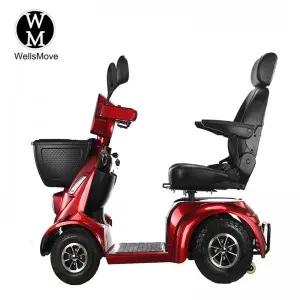Analysis of the international general standards for braking distance testing of electric scooters for the elderly
Introduction
With the intensification of the global aging trend, the market demand for electric scooters for the elderly is growing. For international wholesale buyers, a deep understanding of the international general standards for braking distance testing of electric scooters for the elderly is crucial to ensure product quality, user safety and smooth international trade. This article will analyze the international general standards for braking distance testing of electric scooters for the elderly in detail to help you better understand the relevant requirements.
1. ISO 7176 series of standards
ISO 7176-3:2012: specifies the test method for measuring the braking effect of manual wheelchairs and electric wheelchairs (including scooters), which is applicable to wheelchairs with a maximum speed of no more than 15 km/h and carrying one person. The standard also specifies the disclosure requirements for manufacturers. The test principle is to place the wheelchair or scooter on a specific test platform, simulate different braking scenarios, and evaluate the effectiveness of the brake by measuring parameters such as braking distance, braking time and braking force. For example, when testing on a horizontal road, the vehicle travels at maximum speed, then the brakes produce maximum braking effect, and the distance from the start of braking to the vehicle stopping is measured. The test is repeated many times to take the average value to ensure the accuracy of the data.
ISO 7176-21: Mainly tests the electrical safety and electromagnetic compatibility (EMC) of electric wheelchairs and scooters. Although it is not directly aimed at the braking distance test, the stability of the electrical system has an important impact on the performance of the braking performance. For example, the electrical control components of the braking system need to meet strict electromagnetic compatibility standards to ensure that they can work properly in various complex electromagnetic environments, thereby ensuring the reliability of the braking system.
2. European Standard EN 12184
Basic Requirements: This standard specifies comprehensive test requirements for electric wheelchairs and scooters, including mechanical and durability tests, electrical safety and electromagnetic compatibility (EMC) tests, and other tests. In terms of braking distance testing, the vehicle is required to be fully loaded and tested at the maximum design speed on a horizontal road and maximum safe slope. The braking distance should meet certain limit requirements. For example, for elderly mobility scooters with a maximum design speed of no more than 15km/h, the braking distance of the fully loaded test on a horizontal road is generally no more than 3.5 meters, and the braking distance on the maximum safe slope of 15% slope is no more than 6 meters.
Test method: Special test equipment and instruments are used to simulate different road conditions and usage scenarios to comprehensively evaluate the braking performance of mobility scooters. During the test, the vehicle’s braking system needs to be tested multiple times to ensure the stability and reliability of the results.
3. American Standard ANSI/RESNA WC/VOL.1
Related content: The ANSI/RESNA WC/VOL.1 standard formulated by the American Rehabilitation Engineering and Assistive Technology Association (RESNA) regulates the performance and safety of electric wheelchairs and mobility scooters. In terms of braking performance, the vehicle is required to have an effective braking system and the braking distance is specified. For example, at the specified speed, the braking distance of the vehicle should not exceed a specific value to ensure the safety of the user in various situations.
Testing and verification: Manufacturers need to conduct strict testing and verification of products in accordance with standard requirements, and submit relevant test reports and documents to prove that the products meet the standard requirements. These tests are usually conducted by professional third-party testing agencies to ensure the fairness and accuracy of the test results.
4. Other relevant standards and considerations
GB/Z 18029.3-2021: Equivalent to the ISO 7176-3:2012 international standard, it formulates a test method for brake performance for manual wheelchairs and electric wheelchairs (including electric scooters) for single use with a maximum speed of no more than 15km/h, further standardizing the production and sales of electric scooters for the elderly in the domestic market and making them in line with international market standards.
Test dummies: When conducting braking distance tests, test dummies are usually used to simulate the weight and posture of the user. The specifications of the test dummies should comply with the relevant standards, and their structure and mass distribution should be similar to those of actual users to ensure that the test results can truly reflect the braking performance of the vehicle in actual use.
Test conditions: In addition to the specific requirements in the above standards, test conditions will also affect the results of braking distance. For example, ambient temperature and humidity, road conditions (such as flatness, friction coefficient, etc.) and vehicle load will all have an impact on braking distance. Therefore, when conducting braking distance tests, it is necessary to strictly control the test conditions to ensure the accuracy and comparability of the test results.
5. The significance of ensuring that products meet standards
Safety guarantee: A mobility scooter that meets the braking distance test standards can brake in time in an emergency, effectively avoid accidents, and protect the lives of users.
Market access: For international wholesale buyers, purchasing products that meet international standards is a basic requirement for entering markets in different countries and regions. Products that meet relevant standards can avoid risks such as returns and claims due to quality problems and improve market competitiveness.
Improve product quality: By producing and testing in accordance with international standards, manufacturers can continuously improve product design and manufacturing processes, improve the overall quality level of products, and provide users with better products and services.
6. How to ensure that electric scooters for the elderly meet the braking distance test standards
Strengthen R&D design: Manufacturers should invest more resources in product research and development, adopt advanced braking technology and materials, and optimize the structure and performance of the braking system to meet the requirements of international standards.
Strict production control: During the production process, production and assembly should be carried out in strict accordance with design requirements and process standards to ensure that the braking system of each scooter can achieve a consistent high quality level. At the same time, strengthen the quality inspection of raw materials and parts to ensure that they meet relevant standards and quality requirements.
Third-party testing and certification: Manufacturers can entrust professional third-party testing and certification agencies to test and certify products, obtain authoritative test reports and certification certificates to prove that the products meet international general standards. This can not only improve the market recognition of products, but also enhance the confidence of buyers and consumers in products.
Continuous improvement and optimization: Manufacturers should pay attention to the updates and changes of international standards, as well as market feedback and user needs, and continuously improve and optimize products to improve the braking performance and safety of products.
Conclusion
Understanding the international general standards for braking distance testing of electric scooters for the elderly is of great significance to ensuring user safety, promoting international trade and improving product quality. International standards such as ISO 7176 series, European standard EN 12184, American standard ANSI/RESNA WC/VOL.1, etc. regulate the braking distance test from different aspects, covering test methods, technical requirements, test conditions, etc. Manufacturers should strengthen their understanding and implementation of these standards to ensure that their products meet the relevant requirements, so as to stand out in the fierce market competition and provide safe and reliable electric scooters for the elderly users around the world. At the same time, when selecting suppliers and products, international wholesale buyers should also focus on whether the products meet these international standards to reduce procurement risks and improve the market competitiveness of products.
Post time: May-30-2025



